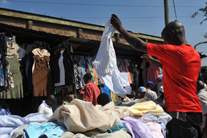Photo credit: Simon Maina via CNN.com
By Shannon Whitehead, a sustainable apparel consultant and columnist for the Ethical Fashion Forum. This post was originally published at shannonwhitehead.com.
How often do you drop off clothes at your local charity shop?
If you’re anything like the rest of the country, Goodwill and Salvation Army are the perfect resources for discarding the stuff that you don’t need.
The pair of jeans that don’t fit you anymore? Donate. The sweater with the small hole in the armpit? Donate. The dress that’s been pushed to the back of your closet? Donate.
Most of us see these donation centers as a way to throw out what we don’t want without actually throwing it out. In fact, we believe we’re doing the world a service by giving our old clothes to those living somewhere in need.
In reality, what we’ve come to believe isn’t that simple. I’d go so far to say it’s fundamentally flawed. Here’s why:
– About 4.7 billion pounds of clothing are donated by Americans each year. Some of that ends up in landfills, some of it is recycled into rags and insulation, and some of it ends up in the markets of Sub-Saharan Africa.
– Whether it’s Goodwill, Salvation Army, Savers or another charity shop, employees at all of these stores are sorting through the hundreds of bags of discarded clothing that comes in every day. Sifting through mostly worn, old and faded garments, only about 10 percent of the clothing donated is good enough to be resold in the retail store.
– So what happens to the other 90 percent? The charity shop sells the garments by weight or by the bin to textile recyclers. The clothing is shipped to a recycling plant where employees sort the garments by “grade” and fiber. As shirts, dresses, pants and jackets come off a conveyor belt, an employee must make a snap decision as to where that piece of clothing will end up next.
– The clothing deemed “re-sellable” is shipped in containers by the tons to countries such as Ghana, Angola, Cameroon, Congo, Tanzania and Rwanda. One hundred pound bales are then sold to sellers in these countries at a profit for the recycling plant. One bale costs around the same amount as feeding a family of five for a month in a country such as Cameroon.
– The bales are not allowed to be opened until the purchase is final. So, the seller is relying completely on the employee who made a snap decision in the recycling center. If a recycler missed a hole in a shirt or a broken zipper on a pair of pants, the seller ends up paying for the mistake. The quality of the clothing is only as good as the recycling plant’s sorting method.
– So, the plant must be pretty strict then, right? Actually, it’s a toss up. While there are responsible recyclers, there are just as many that are lenient and careless. In fact, there is no auditing system or accountability control should an entirely damaged bale show up in Africa. Because the seller needs to make the money back to buy his or her next bale, one bad purchase can result in bankruptcy.
– The global trade of second-hand clothing is a multi-billion dollar industry for developed countries. With our clothing waste being sent overseas by the tons, there’s little chance of African countries, as a whole, developing their own textile trade. In the last 10 years, local industries, such as garment-making and tailoring, have collapsed, leaving hundreds of thousands of workers unemployed.
People will argue that the second-hand clothing industry in Africa is booming. And, on the surface, it is – over one-third of Sub-Saharan Africans wear second-hand. The reality, though, is that for as long as the second-hand clothing industry thrives, Africa economy is unlikely to improve.
According to Professor Garth Frazer from the University of Toronto, no country has ever achieved a sustainable per capita national income (at a level associated with a developing economy) without also achieving a clothing-manufacturing workforce that employs at least 1 percent of the population.
Over the years, certain African nations have attempted to ban or restrict the influx of Western clothing imports. In an effort to give existing industries a chance and to maintain traditional culture, countries such as South Africa, Uganda and Nigeria have tried to implement regulation. While it’s done some good for those countries, it hasn’t provided a solution.
Simply put, as long as we, the consumer, continue to buy and discard at our current rate, there will be a market for our wasted fashion. And we will likely continue to believe that once it’s out of our closet it’s out of our hands.
The facts in this post can be attributed to the research of Lucy Siegle, author of “To Die For: Is Fashion Wearing Out the World?”, an op-ed by Tansy Hoskins in The Business of Fashion and various other sources.



